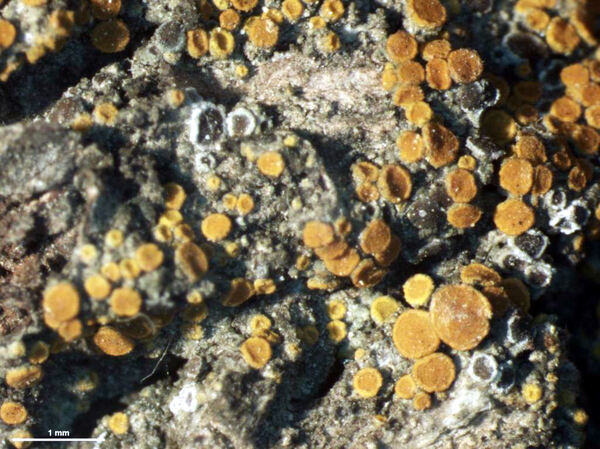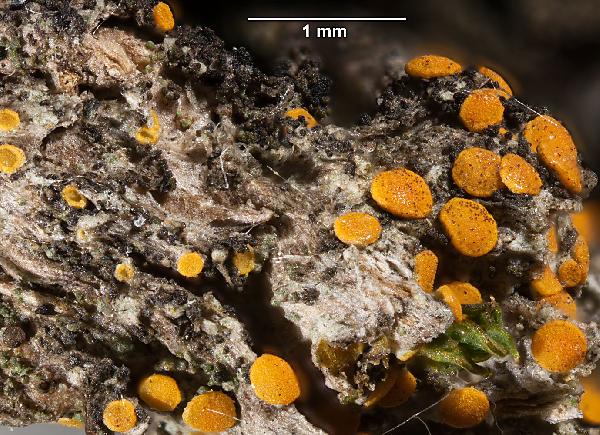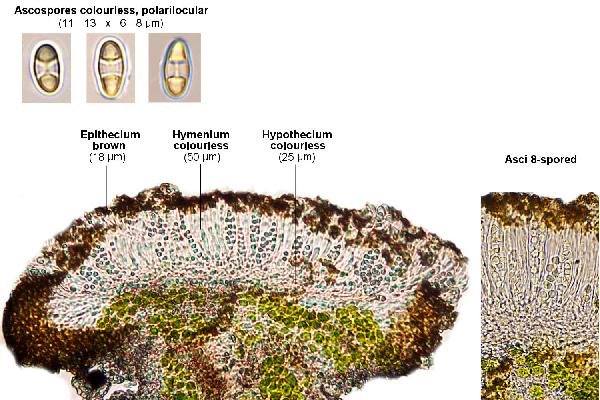Athallia raesaenenii (Bredkina) ined.
provisionally placed here, ICN Art. 36.1b. Basionym: Caloplaca raesaenenii Bredkina - Nov. sist. Niz. Rast., 23: 170, 1986.
Synonyms: Caloplaca geophila Räsänen nom. illegit.; Caloplaca raesaenenii Bredkina; Caloplaca thuringiaca Søchting & Stordeur
Description: Thallus crustose, endosubstratic or thinly episubstratic, of very small, dispersed, greenish grey areoles that may coalesce into a more or less continuous, irregular crust. Apothecia zeorine to biatorine, at first slightly immersed, then sessile, 0.2-0.6 mm across, with an initially concave, then flat, orange disc, a thin, often slightly paler proper margin, and a poorly developed, grey thalline margin often present only on the underside of the apothecia. Proper exciple prosoplectenchymatous, 35-40 μm wide; epithecium brownish orange, finely granular, K+ purple-red, C-; hymenium colourless, 45-60 µm high; paraphyses simple or rarely slightly branched in upper part, 1-1.5 µm thick at mid-level, the apical cells swollen, 4-5.5 µm wide; hypothecium colourless, without oil droplets, often subtended by an algal layer. Asci 8-spored, clavate, functionally unitunicate, apically thickened with a broad internal beak, the inner part of apex and external cap I+ blue, Teloschistes-type. Ascospores 2-celled, polarilocular, hyaline, ellipsoid, 10-13 x 6-6.5 µm, the equatorial thickening (“septum”) 3-4.5 µm, c. 1/3 of spore length. Photobiont chlorococcoid. Spot tests: thallus K-, C-, KC-, P-; apothecia K+ purple-red, C-. Chemistry: thallus without lichen substances; apothecia with parietin (major), teloschistin, fallacinal, parietinic acid, and emodin (minor).
Growth form: Crustose
Photobiont: green algae other than Trentepohlia
Reproductive strategy: mainly sexual
Subcontinental: restricted to areas with a dry-subcontinental climate (e.g. dry Alpine valleys, parts of Mediterranean Italy)
Commonnes-rarity: (info)
Alpine belt: absent
Subalpine belt: absent
Montane belt: absent
Dry submediterranean belt: extremely rare
Humid submediterranean belt: absent
Padanian area: absent
pH of the substrata:
1 2 3 4 5
Solar irradiation:
1 2 3 4 5
Aridity:
1 2 3 4 5
Eutrophication:
1 2 3 4 5
Poleotolerance:
0 1 2 3
Altitudinal distribution:
1 2 3 4 5 6
Rarity
absent
extremely rare
very rare
rare
rather rare
rather common
common
very common
extremely common
Loading data...
Occurrence data
Predictive map
Growth form: Crustose
Photobiont: green algae other than Trentepohlia
Reproductive strategy: mainly sexual
Subcontinental: restricted to areas with a dry-subcontinental climate (e.g. dry Alpine valleys, parts of Mediterranean Italy)
Commonnes-rarity: (info)
Alpine belt: absent
Subalpine belt: absent
Montane belt: absent
Dry submediterranean belt: extremely rare
Humid submediterranean belt: absent
Padanian area: absent
pH of the substrata:
| 1 | 2 | 3 | 4 | 5 |
Solar irradiation:
| 1 | 2 | 3 | 4 | 5 |
Aridity:
| 1 | 2 | 3 | 4 | 5 |
Eutrophication:
| 1 | 2 | 3 | 4 | 5 |
Poleotolerance:
| 0 | 1 | 2 | 3 |
Altitudinal distribution:
| 1 | 2 | 3 | 4 | 5 | 6 |
Rarity
absent
extremely rare
very rare
rare
rather rare
rather common
common
very common
extremely common
Loading data...
Occurrence data
Predictive map









